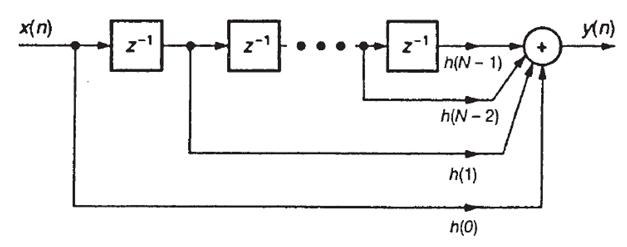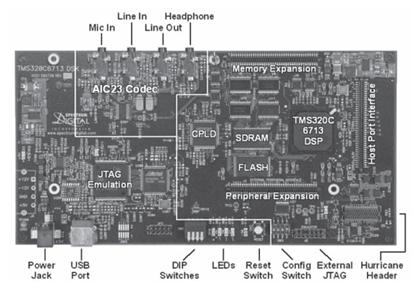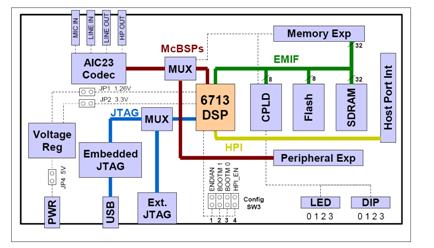|
This project combines the implementation of (six) finite impulse response (FIR) filters,
delay line, and echo effect subprojects using DSP tool TMS320C6713 DSK. The FIR filters are tools used to provide three groups of frequency components per channel
where the gain adjustment gave control to amount of each frequency group was present in output.
Introduction
This project demonstrates channel routing among left and right, signal delay, echo, muting select channels, or application of Low pass, Band pass,
and High pass filters to signal provided Line input and output Lineout/Head phones on TMS320C6713 DSK. The use of FIR filters requires two MatLab modules to produce the filter COF files.
The fdatool function offers the type of filter and design parameters related to chosen filter. Exporting the resulting array variable in MatLab where the dsk_fir67.m program formats the output to a COF file.
The COF files are the coefficients used to implement the FIR filter.

Figure 1: FIR filter structure showing delays
The input signal to the TI DSK 6713 board is sampled in the AIC23 module.
The AIC23 was an ADC section and a DAC section. The DSP reads a unsigned integer 32 (Unit32) value of A/D via the McBsp providing the value present at line input jack.
The DSP writes a Uint32 to AIC23 where it contains values for left and right channels. The DSP is designed to do the FIR math very fast, allowing real-time computations to live signals to line input.

Figure 2: DSK TMS320C6713 circuit board

Figure 3: Block diagram of DSK TMS320C6713
The DSKboard device used in this project comes with a wide variety of
application environments. Key features include:
A Texas Instruments TMS320C6713 DSP operating at 225 MHz.
An AIC23 stereo codec
16 Mbytes of synchronous DRAM
512 Kbytes of non-volatile Flash memory
4 user accessible LEDs and DIP switches
Software board configuration implemented in CPLD
Configurable boot options
Standard expansion connectors for daughter card use
JTAG emulation with USB host interface
Single voltage power supply (+5V)
In this project DIP switches are used to send signal for each event based on the C code. The C code is also attached in this report.
The switch combination application explains what the C code will do to the signal input.

|